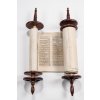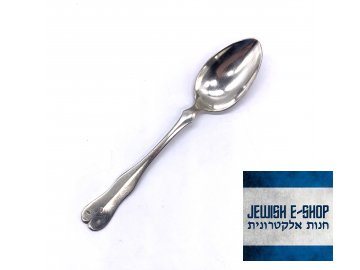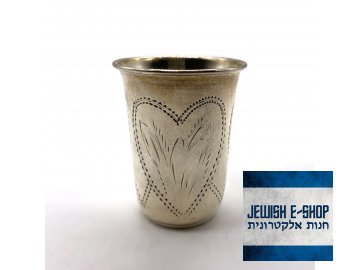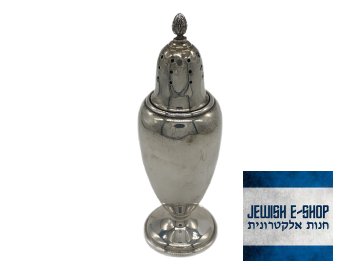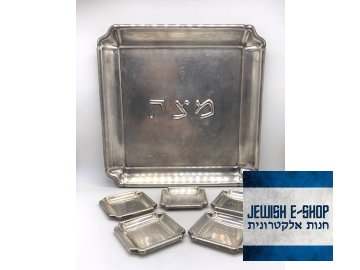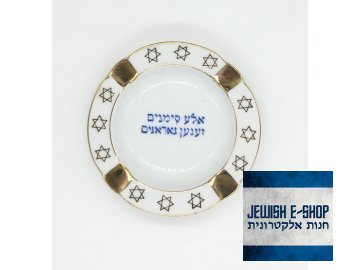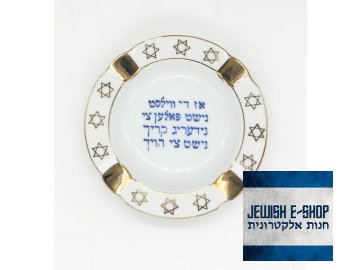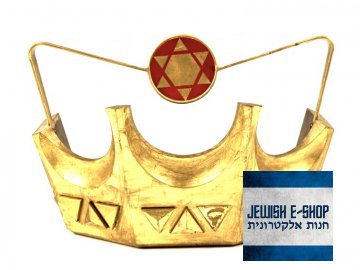Jewish objects
Bestsellers
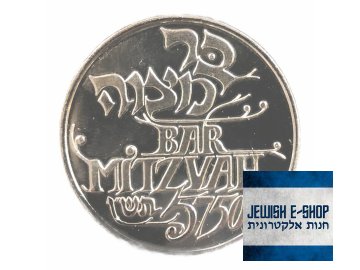
Silver coin for bar mitzvah. Diameter: 39 mm, Weight: 31,20g (1,1oz) Silver commemorative coin with the inscription "Bar Mitzvah" in Hebrew and Latin and the year of issue...
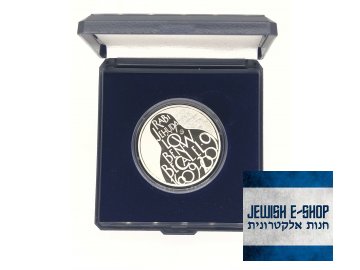
Silver, 13 g, Czech National Bank, silver coin of the important Jewish scholar Rabbi Yehuda Löw ben Becalel Commemorative silver coin issued on the occasion of the 400th...

Silver kiddush cup with engraved decor. Origin in the region of Galicia, ca. 1900. Height: 4.4 cm

Silver kiddush cup with engraved decor. Origin in the region of Galicia, ca. 1900. Height: 4.8 cm

Silver kiddush cup with engraved decor. Origin in the region of Galicia, ca. 1900. Height: 4.5 cm An object of cultural value of a sacred and cult nature - the object is...

Silver kiddush cup with engraved decor. Origin in the region of Galicia, ca. 1900. Height: 4.5 cm

Silver kiddush cup with engraved decor. Origin in the region of Galicia, ca. 1900. Height: 4 cm

Silver kiddush cup with engraved decor. Origin in the region of Galicia, ca. 1900. Height: 4.4 cm

Silver kiddush cup with engraved decor. Origin in the region of Galicia, ca. 1900. Height: 4.3 cm

Silver kiddush cup with engraved decor. Origin in the region of Galicia, ca. 1900. Height: 4.1 cm

Silver kiddush cup with engraved decor. Origin in the region of Galicia, ca. 1900. Height: 4.3 cm

Silver kiddush cup with engraved decor. Origin in the region of Galicia, ca. 1900. Height: 5.3 cm


Kosher Mezuzah scroll 10 cm long - KOSHER!!! Ashkenazi kosher scroll with crowns over letters! MADE in ISRAEL!
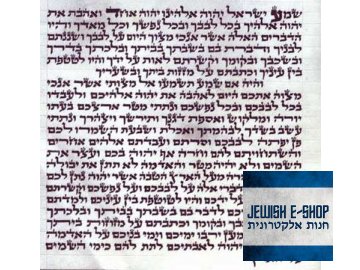
Kosher Mezuzah scroll 7 cm long - KOSHER!!! Ashkenazi kosher scroll with crowns over letters! MADE in ISRAEL!

Silver Kiddush cup Ag 925/1000 from Israel, for spirits
Jewish souvenirs refer to a wide range of objects that are related to the Jewish religion (Judaism), art and culture. In addition to Jewish clothing, examples of Jewish religious objects include the following:
A mezuzah (מזוזה), literally translated from Hebrew as "door frame" or "doorway," is a small box placed on the door frame that contains a parchment scroll with verses from the Torah (part of the Shema Yisra'el prayer). The case in which the scroll is placed is often ornamented and may be made of various materials. The mezuzah is typical of Jewish households or shops, and is one of the 613 commandments mentioned in the Torah. It is customary for observant Jews to touch the mezuzah and kiss the fingers that have touched it as they pass by it. The parchment scroll must be inspected once every seven years by a qualified sofer.
An unadorned animal horn, used as a Jewish religious object on festive occasions, is referred to as a shofar (שופר). Often a ram's horn is used to make it (it is even prescribed for the holiday of Rosh Hashanah), but horns of other kosher animals such as goats, antelopes, and gazelles are also used. The forbidden animal is the cow. According to the Torah, its sound was first heard at G-d's appearance on Mount Sinai. Traditionally, the shofar is used during the holiday of Rosh Hashanah, when it is blown after each morning service. Outside of this holiday, it announces the end of the Yom Kippur fast and, in modern Israel, the inauguration of the president. There is a precise method of blowing the shofar during each holiday that must be observed.
A specific kind of Jewish souvenir may be Israeli souvenirs that have a connection to the modern State of Israel. Among these we can include, for example, the Israeli flag (דגל ישראל, Degel Yisra'el), which is the national flag of the State of Israel. It consists of a white background with two horizontal blue stripes, located at the top and bottom of the flag, and a blue Star of David. Blue and white are the Jewish colours, symbolizing the prayer shroud of the tallit. The Star of David, or Shield of David (Magen David) is a six-pointed star (hexagram) and the most famous symbol of Judaism. The flag itself is based on the Zionist flag, approved at the first Zionist Congress in Basel in 1897.
Hanukkah (חנוכה), also known as the Feast of Lights, is an eight-day holiday that commemorates the successful Jewish revolt (Maccabean Revolt) against the Hellenized Syrians, who religiously persecuted the Jews, and the subsequent miracle that occurred at the dedication of the Jerusalem Temple. It had been desecrated by the Syrians and its rededication involved the lighting of a menorah. But the pure oil with which the candlestick was lighted was only enough for one day. Miraculously, however, the candlestick burned for eight days before new oil could be prepared. Reminders of this miracle are the lighting of candles on Hanukkah candlesticks (chanukiah) and the eating of foods prepared with oil, such as potato latkes and doughnuts (sufganiyot). The holiday is celebrated at the turn of the months of Kislev and Tevet and traditionally falls in late November and December according to the Gregorian calendar.
Passover (פסח), also known as the Feast of Unleavened Bread, is one of the three pilgrimage festivals that commemorates the exodus of the Jews from Egyptian slavery. It is one of the oldest and most important Jewish holidays. It lasts eight days (seven in Israel) and is characterized by special eating habits and customs. These include, for example, the prohibition of the consumption of leavened foods and drinks (bread, beer, whisky) and, on the contrary, the consumption of so-called unleavened bread (matzos). On the first two nights of the holiday (one in Israel) a festive dinner, known as a seder, is held. During this meal, symbolic foods are eaten and the story of the Passover holiday is told. It falls in the second half of the month of Nisan, which is roughly April according to the Gregorian calendar.
Purim (פורים) is a minor and most joyous Jewish holiday. It commemorates the events mentioned in the Book of Esther, according to which the holiday was instituted by Mordecai to commemorate the thwarting of the plans of the vizier and viceroy Haman to exterminate the Persian Jews. It is accompanied by a number of customs, including readings from the Book of Esther, the giving of gifts to the near and needy, feasting with wine drinking and carnivals. The feast falls in the month of Adar, which according to the Gregorian calendar is roughly February to March.
Rosh Hashanah (ראש השנה) is a holiday commemorating the beginning of the Jewish New Year. It is one of the so-called High Holidays and, according to Jewish tradition, falls on the day the world was created. It also marks the beginning of the Ten Days of Repentance, followed by the holiday of Yom Kippur. The holiday should be spent in prayer and remorse. Traditions include blowing the shofar and eating symbolic foods (such as dipping bread and sliced apples in honey, eating carrots and fish heads) and symbolically casting away sins (tashlich). It falls on the 1st and 2nd day of the month of Tishri, which is roughly September to October according to the Gregorian calendar.
Yom Kippur (יום כיפור), also known as the Day of Atonement, is the holiest and most important Jewish holiday. It is one of the so-called High Holidays and falls on the tenth day after Rosh Hashanah, and also concludes the so-called Ten Days of Repentance, during which a person's behavior is weighed in the balance and during which a person is to make amends and atone for any sins he may have committed. It is a fasting holiday dedicated to prayer. According to tradition, it was on this day that G*d forgave the people of Israel for making the golden calf, and it was also on this day that Abraham was circumcised as a sign of his covenant with G*d. It falls on the 10th day of the month of Tishri, which according to the Gregorian calendar is roughly September to October.
Sukkot (סוכות), otherwise also the Feast of Tabernacles, is an eight-day (in Israel, seven-day) holiday that belongs to the so-called pilgrimage festivals. It commemorates the period when the Jews wandered in the desert after coming out of Egyptian slavery. The traditional custom is to set up booths, known as sukkot, under which Jews eat and sometimes sleep during the holiday. The so-called four species (lulav, hadas, etrog, arava) are used in worship. It falls in the month of Tishri, which according to the Gregorian calendar is roughly September to October.
Shavu'ot (שבועות), also known as the Feast of Harvest or Feast of Weeks, is a two-day (in Israel, one-day) holiday, belonging to the so-called pilgrimage holidays. It commemorates the day on Mount Sinai when G*d gave the Torah to the people of Israel through Moses. The holiday also marks the end of the counting of the omer. Customs include eating dairy foods, studying Torah all night, and decorating the synagogue green. It falls in the month of Sivan, which is roughly May to June according to the Gregorian calendar.
Jewellery and jewellery making are among the many areas influenced by Judaism as well as Jewish symbolism and mysticism. Jewish silver, gold and jewellery thus reflect both traditional and lesser-known Jewish symbols.
Among the classical ones is the Star of David (מגן דוד, Magen David, i.e. literally "Shield of David"), which is the six-pointed star (hexagram) and the most famous symbol of Judaism. Although its earliest use dates back to the 7th century BCE, its use as a symbol of Judaism is relatively modern. Neither the Tanakh nor the Talmud mentions it, and its name is thought to refer to the shape of King David's shield. In the Middle Ages it was known as the "Seal of Solomon" and according to Kabbalah its two triangles represent a dichotomy inherent in man (e.g. good × evil, or spiritual × physical). As a religious symbol of Judaism, it began to gain prominence in the 17th century, and by the 19th century it was a widely accepted symbol of the religion. It has been used to mark synagogues, became a symbol of the Zionist movement in 1897 and has been part of the Israeli national flag since 1948. It came into sad use during the Holocaust, when Jews in the territories occupied by Nazi Germany were forced to wear it.
Also popular among Sephardic Jews, in North Africa and in the Middle East region is the hand-shaped amulet known as the hamsa (חמסה, chamsa, from the Hebrew chamesh = five), which is common to Judaism and Islam, although it has different symbolism in each religion. It takes the form of a symmetrical hand that does not reflect human anatomy. It serves as a protective amulet against bewitchment and often includes an eye symbol, a fish or a Hebrew inscription. According to Jewish symbolism, the five fingers represent the five books of the Torah. It is also sometimes referred to as the "hand of Miriam", which was the sister of Aaron and Moses. It is often worn as part of a necklace.
Many Kabbalistic symbols are popular. Kabbalah (קבלה), meanwhile, is a Jewish mystical and esoteric teaching. Its origins can be found in parts of the Tanakh and in the Sefer Yetzirah. In addition to the latter, Sefer ha-bahir and the Zohar are also among the major kabbalistic works. The basis of Kabbalah, which is a secret and complex doctrine, is the unbroken reciprocal relationship between man and G*d, with G*d being seen as an infinite source of power and wisdom. Today, Kabbalah is primarily studied, but in some circles it is still practiced. A specific element is the so-called new-age Kabbalah.
However, in addition to the above, there are many other Jewish symbols that can be purchased as jewelry.

